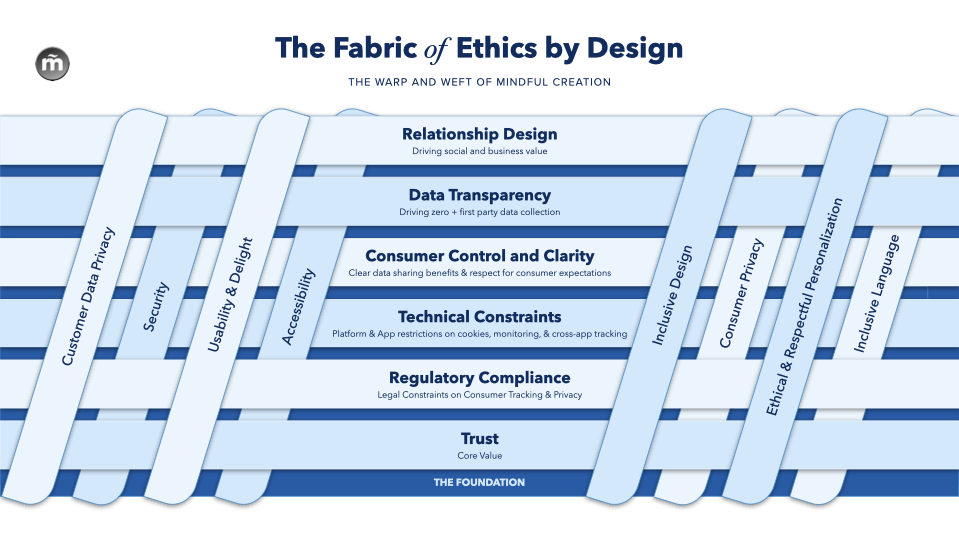In the modern era of UX design, the conversation around ethics has taken center stage—and for good reason. As we continue to build technologies that shape our everyday lives, the onus is on designers to ensure that these innovations are not just functional, but also ethical, inclusive, and trustworthy. Enter the Fabric of Ethics by Design, a framework that underscores the importance of embedding ethical considerations into every stage of product development.
A Complex Tapestry of Ethical Design
The quest for ethical design isn’t a simple checklist or a set of one-time tasks. Instead, it’s a complex tapestry, woven from various threads that run seamlessly through the entire product lifecycle. The Fabric of Ethics by Design helps visualize this intricate process, where every aspect of design—both foundational and emerging—intertwines to form a stronger, more responsible product.
Some of the most crucial threads that make up this fabric include:
- Customer Data Privacy: Upholding the sacredness of personal data by ensuring robust privacy practices.
- Security: Implementing safeguards that protect users from potential harm or breaches.
- Usability & Delight: Ensuring that designs are both functional and enjoyable to use, keeping the user experience at the forefront.
- Accessibility: Crafting products that are usable by people of all abilities, fostering inclusivity.
- Inclusive Design & Language: Incorporating diverse perspectives to create products that resonate with everyone, no matter their background or identity.
- Ethical & Respectful Personalization: Creating personalized experiences that respect user boundaries without compromising privacy or agency.
These threads work together, forming a holistic approach to ethical design. When each thread is carefully woven into the development process, the result is a product that is not only innovative but also responsible.
Intertwined Elements, Interdependent Outcomes
At its core, the Fabric of Ethics by Design recognizes that ethical design is about more than just good intentions—it’s about deliberate action. The framework highlights two key categories:
- Established Competencies: Familiar aspects like user-centered design and accessibility form the backbone of the design process, serving as the foundation upon which ethical considerations are built.
- Emerging Practices: Elements like consequence scanning and inclusive design encourage forward-thinking strategies, pushing us to consider the long-term impacts of our designs on a wide variety of users.
These threads are not isolated from one another; they are interdependent. A failure to address one element, like data privacy, can unravel other aspects of ethical design, such as trust and relationship-building with users. By approaching ethical design holistically, we can create outcomes that reinforce one another and lead to better, more responsible products.
Bridging the Values Gap
Although ethical design aligns with the core values of most designers, turning these values into tangible action requires constant vigilance. Raising awareness within organizations about the financial and reputational benefits of ethical design can often be the difference between a short-term product and a sustainable one. When leadership is convinced that ethical investment is not just the right thing to do, but also beneficial for the bottom line, they are more likely to allocate the resources necessary to integrate ethics into the design process.
The Fabric in Action
The Fabric of Ethics by Design isn’t just a conceptual model—it’s a practical tool for designers and organizations looking to elevate their ethical game. By actively integrating its threads into every stage of product development, the framework provides a blueprint for creating solutions that are:
- Trustworthy: Products that respect user data, privacy, and well-being foster trust and build stronger, more meaningful relationships with users.
- Sustainable: Considering the environmental and social impact of our designs ensures that they contribute to a more positive, long-term future.
- Inclusive: By amplifying diverse voices and perspectives, we ensure that our designs cater to a wide array of needs—not just those of a privileged few.
Unraveling the Potential
The Fabric of Ethics by Design invites us to move beyond simplistic compliance measures and embrace a multifaceted approach to ethical design. As we nurture the diverse threads that make up this framework, we find ourselves weaving a future where technology is not only innovative but also responsible, inclusive, and rooted in trust.
By committing to this approach, we as designers and product leaders can ensure that the products we create today pave the way for a more ethical and inclusive tomorrow. After all, the future of technology lies not just in what we create—but in how we create it.
The Fabric of Ethics by Design gives us the framework to do it right.
This approach to ethical design challenges us to look deeper, to see beyond the immediate product outcomes, and to think about the broader social, environmental, and personal impacts. It’s a call to action for every designer, product leader, and organization to reimagine the role of ethics in the digital age—and to recognize that the products of the future must not only be innovative but also responsible.

